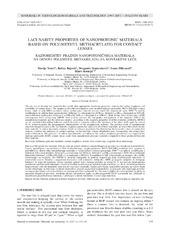Приказ основних података о документу
Lacunarity properties of nanophotonic materials based on poly(methyl methacrylate) for contact lenses
| dc.creator | Tomić, Marija | |
| dc.creator | Bojović, Božica | |
| dc.creator | Stamenković, Dragomir | |
| dc.creator | Mileusnić, Ivana | |
| dc.creator | Koruga, Đuro | |
| dc.date.accessioned | 2022-09-19T18:13:21Z | |
| dc.date.available | 2022-09-19T18:13:21Z | |
| dc.date.issued | 2017 | |
| dc.identifier.issn | 1580-2949 | |
| dc.identifier.uri | https://machinery.mas.bg.ac.rs/handle/123456789/2613 | |
| dc.description.abstract | The aim was to develop new materials that would, after appropriate machining processes, improve the surface roughness and wettability of contact lenses. The samples used in this investigation were standard rigid gas-permeable (RGP) SOLEKO contact lenses, made of poly-MMA-co-siloxy silane methacrylate material (known under the commercial name SP40 (TM)), and its modifications by adding three nanomaterials: fullerene C-60 (designated as SP40-A), fullerol C-60(OH)(24) (designated as SP40-B) and methformin hydroxylate fullerene C-60(OH)(12)(OC4N5H10)(12) (designated as SP40-C). Both atomic force microscopy (AFM) and magnetic force microscopy (MFM) were used to measure the topography and gradient of the magnetic field of the nanophotonic materials and the reference samples. According to the magnetic properties of all the materials yielded by MFM it can be concluded that adding fullerene and its derivatives certainly reduces the spectrum of the phase shifts angle by almost 50 %, which increases the paramagnetic characteristics of the nanophotonic material. The positive result of nanophotonic materials characterization is the fact that the roughness parameter values for all of these materials, are lower than those for the basic material. A surface lacunarity analysis, based on in-house procedures for determining the lacunarity value of contact lens surfaces, confirms the influence of surface topology on the tear film volume distribution and, consequently, the contact lens' surface lubrication. The presence of carbon nanomaterials, according to the surface roughness parameters, are improved for rigid gas-permeable (RGP) contact lenses made from nanophotonic polymer materials compared to those produced from the basic material. | en |
| dc.publisher | Inst Za Kovinske Materiale I In Tehnologie, Ljubjana | |
| dc.relation | info:eu-repo/grantAgreement/MESTD/Integrated and Interdisciplinary Research (IIR or III)/45009/RS// | |
| dc.rights | openAccess | |
| dc.source | Materiali in Tehnologije | |
| dc.subject | surface roughness | en |
| dc.subject | polymer materials | en |
| dc.subject | magnetic force microscopy | en |
| dc.subject | fullerenes | en |
| dc.subject | atomic force microscopy | en |
| dc.title | Lacunarity properties of nanophotonic materials based on poly(methyl methacrylate) for contact lenses | en |
| dc.type | article | |
| dc.rights.license | ARR | |
| dc.citation.epage | 151 | |
| dc.citation.issue | 1 | |
| dc.citation.other | 51(1): 145-151 | |
| dc.citation.rank | M23 | |
| dc.citation.spage | 145 | |
| dc.citation.volume | 51 | |
| dc.identifier.doi | 10.17222/mit.2016.014 | |
| dc.identifier.fulltext | http://machinery.mas.bg.ac.rs/bitstream/id/1340/2610.pdf | |
| dc.identifier.scopus | 2-s2.0-85027410461 | |
| dc.identifier.wos | 000396592900023 | |
| dc.type.version | publishedVersion |


